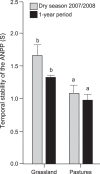More stable productivity of semi natural grasslands than sown pastures in a seasonally dry climate
- PMID: 22590506
- PMCID: PMC3348906
- DOI: 10.1371/journal.pone.0035555
More stable productivity of semi natural grasslands than sown pastures in a seasonally dry climate
Abstract
In the Neotropics the predominant pathway to intensify productivity is generally thought to be to convert grasslands to sown pastures, mostly in monoculture. This article examines how above-ground net primary productivity (ANPP) in semi-natural grasslands and sown pastures in Central America respond to rainfall by: (i) assessing the relationships between ANPP and accumulated rainfall and indices of rainfall distribution, (ii) evaluating the variability of ANPP between and within seasons, and (iii) estimating the temporal stability of ANPP. We conducted sequential biomass harvests during 12 periods of 22 days and related those to rainfall. There were significant relationships between ANPP and cumulative rainfall in 22-day periods for both vegetation types and a model including a linear and quadratic term explained 74% of the variation in the data. There was also a significant correlation between ANPP and the number of rainfall events for both vegetation types. Sown pastures had higher ANPP increments per unit rainfall and higher ANPP at the peak of the rainy season than semi-natural grasslands. In contrast, semi-natural grasslands showed higher ANPP early in the dry season. The temporal stability of ANPP was higher in semi-natural grasslands than in the sown pastures in the dry season and over a whole annual cycle. Our results reveal that, contrary to conventional thinking amongst pasture scientists, there appears to be no increase in ANPP arising from replacing semi-natural grasslands with sown pastures under prevailing pasture management practices in seasonally dry climates, while the temporal distribution of ANPP is more even in semi-natural grasslands. Neither sown pastures nor semi-natural grasslands are productive towards the end of the dry season, indicating the potential importance of the widespread practice of retaining tree cover in pastures.
Conflict of interest statement
Figures




References
-
- Sarmiento G. The Ecology of Neotropical Savannas. In: O Solbrig., editor. translator. Cambridge,, Massachusetts, and London, England: Harvard University Press; 1984. 234
-
- Fisher MJ, Rao IM, Ayarza MA, Lascano CE, Sanz JI, et al. Carbon storage by introduced deep-rooted grasses in the South American savannas. Nature. 1994;371:236–238.
-
- Maass MJ. Conversion of tropical dry forest to pasture and agriculture. In: Bullock SH, Mooney HA, Medina E, editors. Seasonally dry tropical forest. Cambridge: Cambridge University Press; 1995. pp. 399–422.
-
- Scurlock JMO, Johnson K, Olson RJ. Estimating net primary productivity from grassland biomass dynamics measurements. Global Change Biology. 2002;8:736–753.
-
- Baruch Z. Vegetation–environment relationships and classification of the seasonal savannas in Venezuela. Flora - Morphology, Distribution, Functional Ecology of Plants. 2005;200:49–64.
Publication types
MeSH terms
LinkOut - more resources
Full Text Sources

